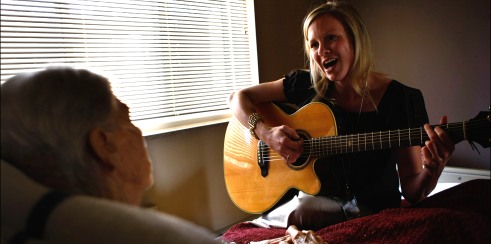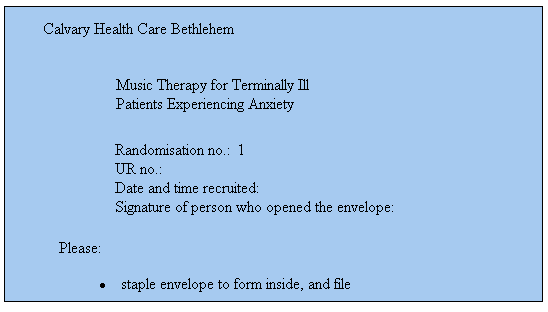Music therapy – Study Design
Interventions
- Control treatment
- Music therapy
Variables measured
Immediately prior to treatment
- Heart rate
- Ratings of 9 symptoms on the Edmonton Symptom Assessment System
- Behavioural Observation Checklist
Immediately after treatment
- Heart rate
- Ratings of 9 symptoms on the Edmonton Symptom Assessment System
- Behavioural Observation Checklist
Other information recorded
- Gender
- Eastern Cooperative Oncology Group performance status
- Duration of treatment

Statistician’s description of the design
The study was a randomised controlled trial. Terminally ill patients were randomly assigned to receive a standard intervention or music therapy.
Calculating the power of the study
When planning the study, Anne thought it was feasible to obtain 30 patients in her control group and 30 patients in her music therapy group. The power of detecting various differences between the two groups was based on 30 participants in each.
Anne hoped to find a greater change in anxiety in the music therapy group compared with the control group. Her primary outcome of interest was the change in anxiety measured by the Edmonton Symptom Assessment System (ESAS) from before to after an intervention. To estimate the power, an estimate of the standard deviation of the change in ESAS anxiety score was needed. Some previous research on patients in palliative care had reported the standard deviation of the ESAS anxiety on two occasions – the first was 2.9cm and the second was 2.8cm. Another study reported that the correlation of ESAS anxiety measured 1 day apart was 0.62. Together this information was used to estimate the standard deviation of ESAS change score as 2.5cm.
The table below shows the power for various average differences between the groups; the power for detecting an average difference of 1cm, for example, is 0.33. The average confidence interval width for the mean difference between the groups is 2.6, if the sample size is 30 in each group and if the standard deviation of the ESAS change score is 2.5cm. Of course, the confidence interval in the actual study will be subject to random variation, and will have slightly different location and width.
| True average difference between groups in anxiety change | Power |
|---|---|
| 0.5 | 0.12 |
| 1.0 | 0.33 |
| 1.5 | 0.63 |
| 1.8 | 0.78 |
| 2.0 | 0.86 |
| 2.5 | 0.97 |
These illustrative calculations are based on the correlation between the two measurements of ESAS anxiety scores (before and after the intervention) being about 0.6. This estimate of the correlation came from a study where ESAS anxiety was measured 1 day apart. Anne planned to measure anxiety twice within a two-hour period, so it was possible that the correlation between the two measurements would be higher than 0.6.
Randomisation procedure
A statistician prepared a randomisation list. Sixty patients were randomised to either the control or music therapy groups in (six) blocks of ten. The randomisation procedure ensured that there were five patients assigned to each treatment in each block.
The statistician prepared 60 envelopes providing the randomisation for each of 60 patients. Each envelope was numbered from 1 to 60; the randomisation was inside. The envelopes were kept at the hospital where the study was being conducted. When the first patient had been recruited to the study, the first enveloped was opened; when the second patient was recruited, the second was opened, and so on. Anne or another music therapist involved in the study opened the envelope.

